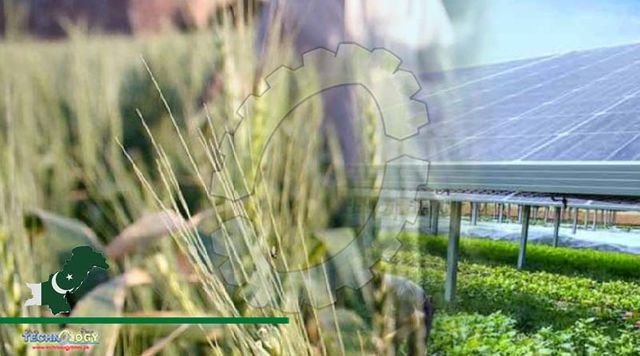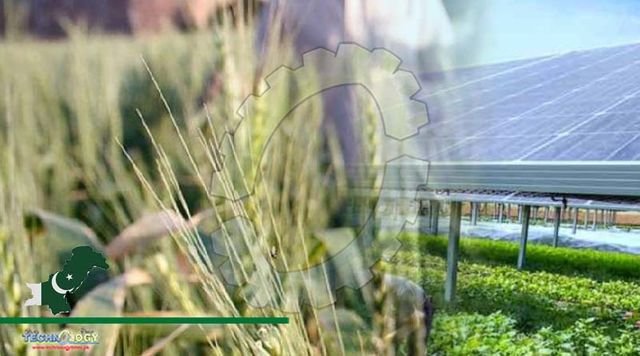Agro-voltaic farming, power production athough it is said that there is ample land on earth to accommodate all solar power that we want, there are land availability issues when one starts looking for land for installing solar power plants – land is not available, is expensive or there are better or more vital uses such as growing food on it.

Unencumbered and cheaper land is available far from the point of use, increasing transmission and distribution cost. Solar panels occupy space and stop solar rays reaching the soil and plants.
They have found a way – do farming and solar energy production together. We will discuss in the following, the prospects and potential of this proposition in Pakistan.
One solution is to install solar panels at such a height (say around 3 metres) so that the panels do not block the land except the columns which may create some hindrance only. The other is to install bi-facial solar panels which have made their debut recently.
There are multiple advantages and synergies – used water from solar panel washing can be used on crops. Solar planners prefer to use farmland over arid land. Farmlands have lower temperatures than the arid land and there is moisture as well, which offers some cooling.
Thus, the threat of diversion of agricultural land to solar can be avoided or reduced by agro-voltaic. What is amusing is that in some cases, it is even beneficial for some agricultural crops that there is some solar hindrance partly to save it from excessive heat, which may be injurious to the crop and cause water loss.
The issue is what those crops are and what the matches between solar timings and crop requirements are. This means that there is no one-size-fit-all solution. Impacts may be variable requiring research and consequent rules and public policy thereof.
There are three countries that have made major agro-voltaic installations – China, Japan and Korea. Europe has done quite some R&D on it. Japan and Korea have land availability issues, while China has a lot of arid land. Pakistan seems to have the same issues as China in this respect.
In China, an agro-voltaic plant has been installed on the periphery of Gobi desert. Berries are grown along with solar panels of 700MW. In Japan, a 35MW agro-voltaic plant has been installed in 2018. Japanese law requires that the loss of agricultural land should not exceed 20%.
In India, Cazri (Central Arid Zone Research Institute) has been researching on the subject. A number of villages have been tried and a policy for land classification in this context has been made. In the US, agro-voltaic installations have reached the level of 2,900MW.
A study done by the University of Arizona and Maryland estimated that there is a cooling of 16-degree Fahrenheit, which is created by the agricultural crops under solar panel, thereby increasing solar output by 2%.
It also reduced water consumption by 15% or more. Underneath, some crop output (fruits and vegetables) under solar panels increased by 100-300%. As to the additional cost, only taller columns (3 metres or higher or lower) may cost some. But there is cost reduction in the form of literally no land requirement for solar while agriculture continues without major loss.
Farmers can earn extra revenue by renting the air at a height of 3 metres and columnar land space or can install their own projects. Agriculturists and landowners belonging to Jhelum may find it quite attractive in the near term. There are agricultural areas in Balochistan (Khuzdar, Kachhi and upwards to Qila Saifullah), which may be interested readily.
Criticism has been made against the choice of land for large-scale projects such as Quaid-e-Azam Solar Park; diversion of land and water. Solar productivity has been lower due to the dusty environment of the arid area. Also high temperatures were held responsible for lower solar efficiency.
However, with increase in solar power installation, optimal land tracts may get lesser and lesser. Nor would one like to make a case for agro-voltaic everywhere. However, the idea or proposal of agro-voltaic may get increased attention in the coming days.
Source: This news is originally published by tribune
